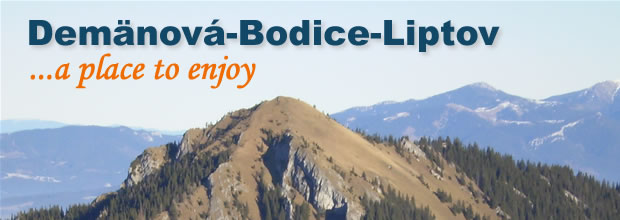Hiking
The Low Tatras is a mountain range dividing the regions of Liptov and Horehronie. Its length is approximately 80 km and width 30 km. There are three peaks whose altitude is more than 2 000 metres – Ďumbier (2043m), Chopok (2024m), and Dereše (2004m). These three as well as Chabenec (1955m) and Kráľova hoľa (1948m) offer beautiful views over a part of Slovakia. The Low Tatras is one of the most frequently visited mountain ranges in Slovakia. Holiday resorts have been built on the southern and northern side of the Low Tatras in 20th century. Despite the rise of tourism in this area, there is rich fauna and flora.
Many interesting tours can be taken in the mountain range. The most attractive for tourists is the ridge tour (Cesta hrdinov SNP – The Slovak National Uprising Heros‘ Route). The busiest is the part between Chopok and Ďumbier, which offers great view over the valleys in the Low Tatras.
The best-known holiday resorts are found in the middle part of the Low Tatras, under the peak of Chopok. Demänovská Valley, with the resorts Lúčky, Záhradky, and Jasná, lies in the northern part. Bystrá Valley, with the resorts Tále, Srdiečko, Kosodrevina, and Mýto pod Ďumbierom, is in the south. There are ski resorts in Čertovica – Čertova svadba and STIV – in the middle part of the Low Tatras. Bocianska Valley, in which there are picturesque villages Vyšká Boca (ski resort Bačova roveň) and Nižná Boca, is another part attractive to tourists. The best-known resort of the western part of the Lown Tatras is Donovaly.
Liptovský Mikuláš is the main starting point for tours to Chopok – North (Demänovská Valley), whereas Podbrezová and Brezno are starting points for tours to Chopok – South (Bystrá Valley, Krpáčovo).
In 1964, a separate village was established in the Demänovská Valley – Demänovská Dolina.
The High Tatras is Slovakia‘s most visited mountain range. It is located at the northern national border with Poland. It is one of the smallest mountain ranges with an alpine character in the world. Its ridge is 26 km long and there are 32 valleys. The High Tatras was declared the first national park in Slovakia in 1949. It gained its shape by the glacial activity in the Quaternary Period. At that time, typical rocky peaks (e.g. Gerlachovský Peak, Lomnický Peak, Kriváň, Rysy), deep glacial valleys (e.g. Mengusovská Valley), moraines and tarns (e.g. Štrbské Tarn, Skalnaté Tarn) arose. The tallest peak in both the High Tatras and Slovakia is Gerlachovský Peak (2655m).
In the Tatra region, there are many interesting places from the historical point of view (e.g. Kežmarok – castle; Spišská Sobota; Levoča – St. James‘ Church; Spišský Castle, Bardejov – historical square). The best-known holiday resorts are in Starý Smokovec, Štrbské Pleso, Tatranská Lomnica, and Ždiar.
It is the most frequently visited holiday resort and the most beautiful valley in the Low Tatras. It is 16 km long and is the best-known centre of tourism on the northern side of the Low Tatras. It is a part of the National Park of Low Tatras.
Its upper part is delimited by four peaks – Siná (1560) in the northwest, Krakova hoľa (1751m) in the northeast, Ďumbier (2043m) in the southeast, and Poľana (1889m) in the southwest. In the middle part of the southern side of the valley, on the main ridge of the Low Tatras, there is Chopok (2024m). Two rivers – Demänovka and Zadná voda – flow through the valley. The activity of the Quaternary glaciers created huge glacial cirques and extensive moraines with Vrbické Tarn and a small tarn in Luková Valley. The lower part, beginning with the confluence of Demänovka and Zadná voda, is a limestone canyon, in which the two rivers have been creating a system of Demänovské caves. Demänovská Cave of Liberty and Demänovská Ice Cave are open to the public.
The valley was settled in prehistoric times, as was proven by archaelogical findings in Okno Cave. In 18th and 19th centuries, ore was mined in the valley and there were chalets and loggers‘ houses. People‘s interest in the valley increased dramatically after the discovery of Demänová Cave of Liberty in 1921.
The visit rate increased, especially in winter, after a chairlift from Jasná to Chopok had been built (the first part in 1949). The village Demänovská Dolina came into existence on 1 August 1964, after Tri studničky, Jaskyne, Repiská, Lúčky, Záhradky, and Jasná merged together. Originally, Jasná was only the name for the upper parts of the valley, but for lovers of skiing the collocation Demänovská Dolina –Jasná means the best-equipped ski centre in Slovakia.
Vlkolínec belongs to the municipality of Ružomberok and it is found in the Veľká Fatra mountain range. It was declared a protected area of folk architecture in 1977, and in 1993 it was added to the List of the World's Heritage of UNESCO. The reason for the addition is that 45 original houses have been preserved in the village. The houses were built in the 19th century and are wooden, the only exception is the Church of the Visitation of the Virgin Mary which was built in 1875 an is made of bricks.
A 1770 belfry and a 1860 well have been preserved in the centre of the village.
It is the youngest open-air museum in Slovakia and was opened in 1991. It was built to save precious monuments of folk architecture from destruction during the construction of Liptovská Mara dam. In addition to wooden folk architecture (farmers‘ and craftsmen’s houses, village school, smithy, fire station, belfry, etc.), there is also the Virgin Mary's Early Gothic Church (built in 1288) and the Manor House from Parížkovce. Farm animals, such as sheep, goats or poultry, are also part of the exhibition.
add to favorites | set as home page | links | partners |














